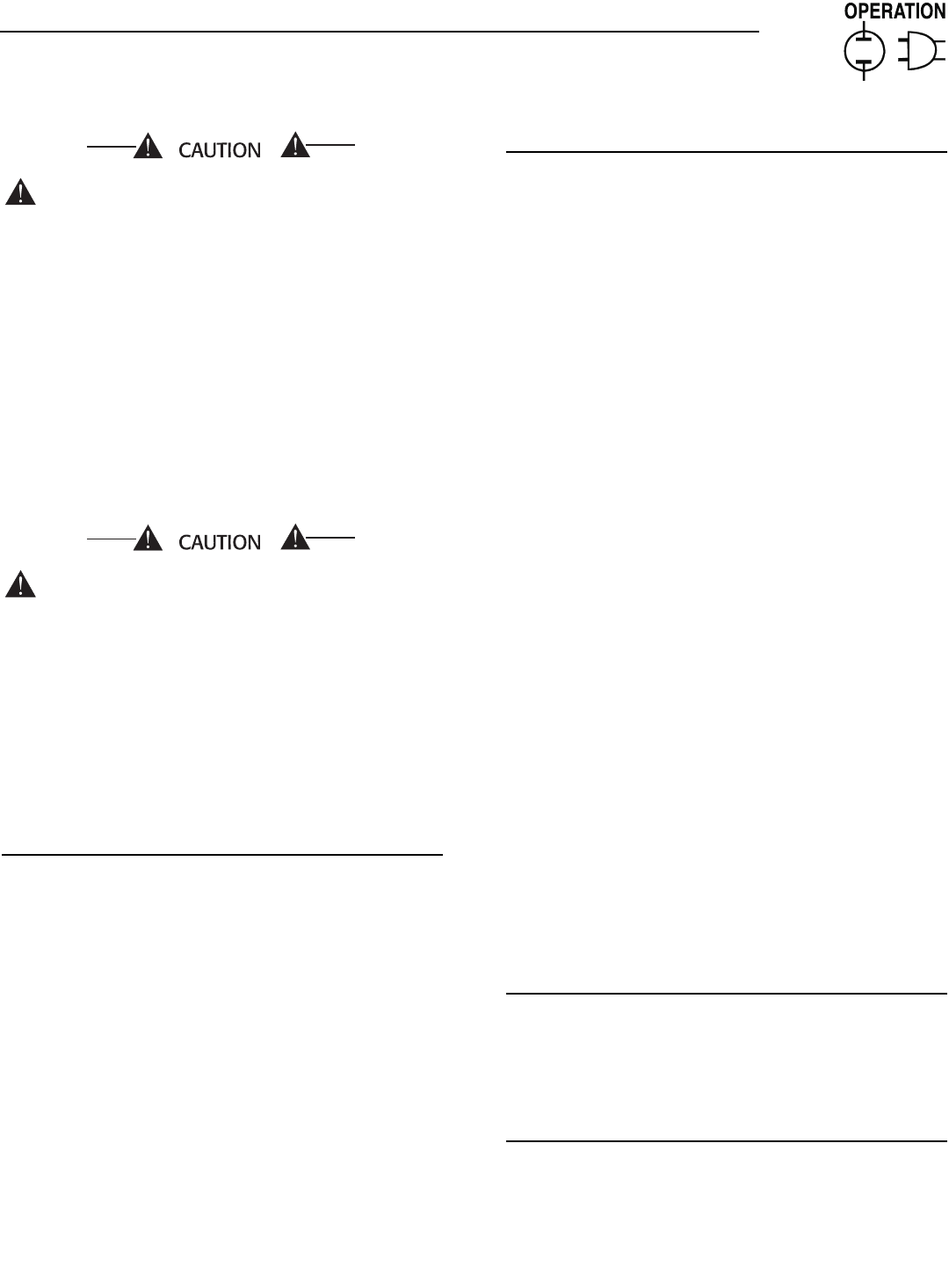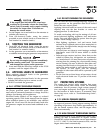
Generac
®
Power Systems, Inc. 9
Section 2 – Operation
QUIETPACT™ 65D Recreational Vehicle Generator
If the engine does not start after it has been
cranking for 15 seconds, release the Start/Stop
switch, wait 15 seconds, and try again. Holding
the switch for longer than 15 seconds can
damage the starter motor.
4. Let the engine run at no-load for a few minutes to
stabilize and warm up.
5. Turn ON electrical loads, using the means
provided in your vehicle (such as, a main-line cir-
cuit breaker or transfer switch).
2.5 STOPPING THE GENERATOR
1. Turn OFF all electrical loads, using the means
provided in your vehicle (such as, a main-line cir-
cuit breaker or transfer switch).
2. Let the generator run at no-load for a few minutes,
to stabilize internal engine generator temperatures.
Do not stop the engine/generator immediately
after running under load. This can overheat
and damage the engine and/or generator.
3. Press and hold the Start/Stop switch in the STOP
position, until the engine shuts off.
2.6 APPLYING LOADS TO GENERATOR
When applying electrical loads to the generator,
observe these guidelines:
• Before applying electrical loads, let the generator
stabilize and warm up for a minute or two.
• DO NOT overload the generator.
2.6.1 LETTING THE ENGINE STABILIZE
The generator supplies correctly rated voltage only at
the proper governed speed. Some electrical appli-
ances may be extremely sensitive to voltage. Incorrect
voltages can damage such appliances.
Electrical loads applied on the engine at reduced
operating speeds, such loads imposed on the engine,
when sufficient power is not available, may shorten
engine life. Never turn ON electrical loads until after
the generator engine has started and stabilized at no-
load.
2.6.2 DO NOT OVERLOAD THE GENERATOR
You can read the rated wattage/amperage capacity of
your generator on the generator data decal located
below the user control panel.
Applying electrical loads in excess of the unit’s rated
capacity may trip the line breaker or cause the
engine/generator to shut down.
To avoid overloading, add up the wattage of all con-
nected electrical lighting, appliance, tool, and motor
loads. This total should not be greater than the gen-
erator’s rated wattage capacity.
• Most lighting, appliance, tool, and motor loads
indicate their required watts on their nameplate or
data plate. For light bulbs, simply note the wattage
rating of the bulb.
• If a load does not show its rated wattage, multiply
that load’s rated VOLTS times AMPS to obtain
WATTS.
• Induction-type motors (such as, those that run the
vehicle’s furnace fan, refrigerator, air conditioner,
etc.) need about 2-1/2 time more watts of power for
starting than for running (for a few seconds during
motor starting). Be sure to allow for this when con-
necting electrical loads to the generator. First, cal-
culate the watts needed to start electric motors in
the system. To that figure, add the running
wattages of other items that will be operated by the
generator.
• For the first two or three hours of operation, do not
apply electrical loads over 75 percent of the unit’s
rating.
2.7 PROTECTION SYSTEMS
The engine has several safety switches that cause
it to automatically shut down, under the following
conditions: low oil pressure, high coolant tempera-
ture, and engine overspeed. See Figure 2.2 (Page 10)
for the location of these devices. If automatic shut-
down does occur, refer to “Troubleshooting Guide”,
on page 37.
2.7.1 LOW OIL PRESSURE SWITCH
This switch is normally closed (N.C.) but is held open
by engine oil pressure during engine running. Should
operating oil pressure drop below approximately 10
psi, the switch contacts close, and the engine shuts
down automatically.
2.7.2 HIGH COOLANT TEMPERATURE SWITCH
This normally-open (N.O.) thermostatic switch has a
sensing tip that is immersed in captive coolant.
Should the coolant temperature exceed approximate-
ly 115° C (240° F), the switch contacts close, and the
engine shuts down automatically.
◆
◆
◆
◆


















